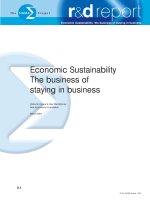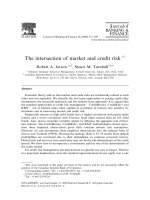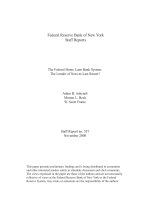The Business of Running a Hedge Fund ppt
Bạn đang xem bản rút gọn của tài liệu. Xem và tải ngay bản đầy đủ của tài liệu tại đây (758.04 KB, 9 trang )
The Business of Running
a Hedge Fund
Executive Summary
2010 was a transformative year for the hedge fund industry and
served as a strong reminder that managing money is not the same
as running a business. The signicant number of small, mid-size and
large fund closures already in 2011 provides continuing evidence of
the material, multifaceted challenges facing operators of hedge fund
businesses. Managers who understand the distinction between man-
aging money and running a business and who execute both effec-
tively are best positioned to maintain a sustainable and prosperous
business – to achieve not only investment alpha, but also enterprise
alpha.
This paper examines the hedge fund business model and is based
on our observations and numerous conversations with hedge fund
managers, investors and industry experts. Our goal is to share the
best practices we have witnessed among “green zone” hedge funds
that are well positioned for sustainability across a variety of economic
and market conditions.
FEBRUARY 2011
In the Zone: Three Types of Hedge Fund Operating Models
Revenue /
Expense
Level ($)
Assets Under Management ($)
Low Fixed
Expenses
Medium Fixed
Expenses
High Fixed
Expenses
Management Fee Revenue (1.5% of AUM)
Anticipated Incentive Fee Revenue (20% of Performance)
Red
Zone
Yellow
Zone
Green
Zone
Best Practices for Getting to the “Green Zone”
M
ost hedge fund managers would agree: given the broader market environment and the
specic challenges facing the industry, 2010 was a difcult year. In fact, the past few
years have tested the industry in unprecedented ways. The industry, by and large, has
passed that test, and there are a wealth of excellent funds operating today that are
poised for growth.
Managers are more focused than ever on designing their business models to thrive under a wide
range of market scenarios. While performance and AUM growth are still important levers in the
hedge fund business model, they are no longer foregone conclusions and are not wholly controlled
by the hedge fund manager. Expenses are the only lever the manager can reliably control.
While there is no one-size-ts-all business model for hedge funds, there are several consistent ele-
ments and best practices we have witnessed among well-managed funds with staying power.
As a starting point, the diagram below highlights the basic revenue and expense scenarios that
describe three types of hedge fund operating models: red zone, yellow zone and green zone. A
www.merlinsecurities.com
PAGE 2
THE BUSINESS OF RUNNING A HEDGE FUND
The two most important levers for a hedge fund’s basic business model are its fees and its xed expenses. The green zone below
represents funds that keep their xed expenses lower than their management fee revenue. Such funds have a margin of safety
built into their model and can withstand difcult market environments. Yellow zone funds, which spend more than their manage-
ment fee but less than their realistic performance fee expectations, require some degree of positive performance revenue to stay
protable. Funds in the red zone may be forced to take drastic, unplanned actions during soft-performing years.
IN THE ZONE: THREE TYPES OF HEDGE FUND OPERATING MODELS
Revenue /
Expense
Level ($)
Assets Under Management ($)
Low Fixed
Expenses
Medium Fixed
Expenses
High Fixed
Expenses
Management Fee Revenue (1.5% of AUM)
Anticipated Incentive Fee Revenue (20% of Performance)
Red
Zone
Yellow
Zone
Green
Zone
fund operating in the red zone is dependent on outsized per-
formance to cover its expenses; a fund in the yellow zone
requires minimal performance; and a green zone fund can
sustain itself when its performance is lower than expected,
nonexistent or even negative. Funds that structure their busi-
ness model to operate in the green zone are better positioned
to navigate through downturns and therefore have higher sur-
vival rates over the long term.
The remainder of this paper examines hedge fund revenue
inputs, expenses and business model considerations. We
discuss the importance of identifying a fund’s breakeven
point (i.e., the point at which revenues cover expenses) and
seek to isolate several practices that have helped funds oper-
ate in, or closer to, the green zone.
THE HEDGE FUND REVENUE MIX
Hedge funds have two revenue inputs: the management fee,
which is a xed percentage of assets under management
(AUM), and the performance fee, which is a percentage of
positive performance. Incentive fees are what lure the most
talented nancial professionals to join the hedge fund indus-
try, and they offer tremendous upside. It’s the management
fee, however, that keeps people alive in this industry. While
tempting, it is risky to build a business around the hope of
large incentive fees rather than the guarantee of manage-
ment fees.
To better understand the relationship of these revenue inputs,
consider some basic scenarios. Based on a 1.5% manage-
ment fee and 20% incentive fee,
1
a fund with no returns is
www.merlinsecurities.com
PAGE 3
THE BUSINESS OF RUNNING A HEDGE FUND
1
For consistency, this paper uses the “1.5 and 20” fee structure throughout.
THE BIG FIVE HEDGE
FUND EXPENSES
Where do hedge funds allocate
most of their spending? The answer
to that question also explains where
funds can nd opportunities to lower
their expenses.
1. People and HR
2. Ofce space
3. Technology
4. Manual processes
5. Third-party providers (e.g., or-
der management systems, risk,
aggregation, analytics for inves-
tors, allocation tools)
$4.5M
$2.5M
$13.75M
$3.75M
$15.75M
$6.75M
$1.5M
$48.75M
$11.25M
18.75M
100% dependant on its management fee. A fund with gross returns of 5% gets 60% of its revenue
from management fees. In order to derive more than 50% of its revenues from performance fees, a
fund needs to generate returns of at least 7.5%. Refer to the chart below for a map of hedge fund
revenues based on a variety of asset and performance levels.
Putting some real numbers around this provides more color. A fund with $200 million in AUM and
zero or negative performance would generate revenue of $3 million. A return of 5% bumps the total
revenue up to $5 million. With a 7.5% return, the fund’s revenues are $6 million: $3 million from the
management fee and $3 million from the performance fee. Beyond the 7.5% performance mark, the
incentive fee becomes the primary revenue contributor.
The performance fee effect is what makes the hedge fund model so appealing and unique. Where-
as traditional asset management models derive revenues almost exclusively based on assets, a
hedge fund’s revenues include performance incentives, thereby better aligning the interests of the
manager and the investor. If the $200 million AUM fund mentioned above delivers a 25% return,
the manager’s revenue is $13 million – more than double what the manager would receive for a
www.merlinsecurities.com
PAGE 4
THE BUSINESS OF RUNNING A HEDGE FUND
What level of assets does a fund require to support its expenses? Where does performance need to be? The chart below
depicts both sides of the revenue map: AUM and performance, including negative performance.
THE AUM / PERFORMANCE MAP
Hedge Fund Fee Revenues Under Various
Performance and AUM Scenarios
Assets Under Management (millions)
$200 $400 $600 $800 $1,000
Fund Performance
-15%
-10%
-5%
0%
5%
10%
15%
20%
25%
30%
very healthy 7.5% return. By comparison, a similarly sized
mutual fund would earn roughly $3 million in management
fees. This distinction drives our industry. (The chart on
page 8 provides an additional visual of how performance
fees contribute to the revenue mix.)
Looking more closely at the revenue inputs, two clear con-
cepts emerge regarding the hedge fund business model.
First, because hedge funds can be opportunistic with how
they invest, both the manager and investor stand to benet
tremendously when the manager performs well. Second,
there is only one consistently reliable revenue input for
funds: the management fee. Not surprisingly, the manag-
ers we work with who are most sustainability-minded think
of their revenues in terms of their management fee alone.
www.merlinsecurities.com
PAGE 5
THE BUSINESS OF RUNNING A HEDGE FUND
“
”
A conservative place
to start with the hedge
fund business model
is to base revenue
expectations on man-
agement fees alone.
In fact, we recommend that a conservative place to start with the hedge fund business model is to
base revenue expectations on management fees alone. This provides both the fund and its investors
with a margin of safety. Even during periods of low or no returns, a conservatively modeled fund can
sustain, adapt and emerge.
DETERMINING THE BREAKEVEN POINT
When companies calculate their breakeven points, they often come at it from the perspective of how
much revenue they require to cover their expenses: “If we don’t sell $2 million worth of widgets this
year, we’ll face a shortfall and we’ll need to downsize.” Similarly, a hedge fund manager may ask:
“What level of assets and performance do I need to cover my expenses?”
However, the hedge fund business model allows for a different approach. Since hedge funds have a
xed revenue stream – their management fee – and since they know their current level of AUM, they
can work out their breakeven point from the other direction: “What level of expenses can I support
with my xed revenue?” Referring to the business model graphic on page 2, a fund can approach its
breakeven point by pegging its expenses to the point on the graph where its management fee inter-
sects with its AUM level.
www.merlinsecurities.com
PAGE 6
THE BUSINESS OF RUNNING A HEDGE FUND
The $200 million AUM fund described earlier could therefore base its annual revenue projections
around its $3 million management fee (i.e., 1.5% of AUM) and set its expense caps accordingly. Dur-
ing a strong-performing year the fund will run with a surplus which, like other businesses, it can use for
capital expenditures, incentive bonuses, cash reserves and so forth.
A start-up fund can apply the same principal based on realistic AUM assumptions. (For most funds, “re-
alistic” start-up capital consists of investments by partners, friends and family.) A fund with $20 million
in start-up capital and a 1.5 and 20 arrangement could base its expense considerations on $300,000 of
annual xed revenue – a considerably lower amount than in the previous example.
It’s also important for managers of start-up funds to understand the numerous expenses associated
with operating a hedge fund. As an example, many funds – like the $20 million fund described above –
cannot afford a non-bundled third-party vendor’s order management system (OMS), risk management
product, aggregation service, trade allocation module and attribution tools. Once a fund understands
its expenses, it can determine exactly the asset level and performance combination necessary to cover
those expenses and have an adequate prot.
For a prospective start-up fund, this analysis will determine whether the business plan is realistic or
needs renement before it launches (i.e., either the fund will need to raise more launch capital or lower
its xed expenses). For an established fund, this analysis determines whether it is operating in the red,
yellow or green zone.
GETTING TO THE GREEN ZONE
It’s important to understand why some funds target operating in the green zone, and why other funds
may intentionally operate in the yellow or red zones. The green zone calculus is simple: when a fund
maintains xed expenses that are lower than its xed revenues, it operates with a margin of safety. In a
green zone fund, both the fund and its investors have a reasonable cushion to ride out difcult periods
of low or no performance, and the fund operates with less business risk.
In other cases, a manager may wish to operate in the yellow or even red zone, relying on performance
to cover any expenses that are above and beyond its xed revenue. This is particularly true among
start-up hedge funds, which – like other start-up companies – require initial investments and operate
with a higher burn rate. Additionally, any fund that is signicantly building out its infrastructure may op-
erate with higher relative xed expenses, even if just for a short period of time.
We advocate that both new and established funds con-
stantly work toward getting to the green zone. This is key
to managing a sustainable fund.
Distinct from raising AUM, delivering strong performance
or changing the management fee structure, the only lever
that managers have complete control over is xed expens-
es. Using this lever and reducing expenses will enable
funds to get to the green zone. Looking at the breakeven
analysis from a different perspective, reducing xed ex-
penses has a multiplier effect on the level of assets re-
quired for a fund to break even.
For instance, based on the pure management fee model
described above, a fund with a 1.5% management fee and
xed expenses of $600,000 would break even at $40 mil-
lion in AUM. By decreasing xed expenses by $60,000, or
www.merlinsecurities.com
PAGE 7
THE BUSINESS OF RUNNING A HEDGE FUND
“
”
Funds can get closer
to the green zone by
shifting some of their
expenses from xed
to variable and by
moving the burden
of expenses to the
shoulders of a third-
party service
provider.
10%, the fund’s breakeven AUM drops by $4 million to $36 million. Stated differently, $15,000 in xed
expenses equates to $1 million in AUM.
In some cases, reducing xed expenses may mean cutting excess and non-core spending across the
board – including measures such as reducing headcount, taking smaller space and cutting budgets
by a prescribed percentage in each area. Sometimes such draconian measures are necessary – e.g.,
for a prospective start-up fund which is budgeting $25,000 in expenses per million dollars of AUM, or
for a fund whose AUM has decreased signicantly. Very often, however, funds can get closer to the
green zone by shifting some of their expenses from xed to variable and by moving the burden of
expenses to the shoulders of a third-party service provider.
Like many businesses, hedge funds have to make difcult decisions about which tasks they should
perform in-house and which they should outsource. Third-party service providers are available to do
nearly all of a fund’s activities outside of making investment decisions. Our observation is that funds
typically prefer to do as much of their work in-house as is possible. As a result, they tend to build up
signicant xed costs.
Some hedge funds are concerned that reliance on a third-party will increase risk or lead to an opera-
tional or compliance failure. Many emerging managers come from larger funds and have therefore
never developed relationships – or negotiated contracts – with third-party vendors. They believe that
if they don’t do it themselves in-house it won’t get done correctly. This may have been correct in the past
with certain functions, like fund administration, but that’s no longer the case today.
Hedge funds rely on the economies of scale available through third-party providers all the time. They
don’t borrow stock directly; they leverage the scale of their prime broker. They don’t issue commercial
paper directly to nance long positions; they leverage the banks. Similar opportunities exist across a
wide range of fund activities, from trading and technology, to human resource support, to risk manage-
ment and reporting.
By moving the burden of high-expense activities from their own P&L to a service provider, hedge funds
can reduce their xed expenses. The resulting model is leaner and more effective, and it can be scaled
up or down with greater ease depending on the fund’s performance, assets and business needs. As
a fund grows, for instance, it may require more back ofce support, but if the fund’s growth levels off,
some of that support will no longer be necessary.
By leveraging third-party providers, the fund stays nimble and is able to ramp up its productivity without
adding signicant new recurring expenses in the form of compensation, space, technology and so forth.
www.merlinsecurities.com
PAGE 8
THE BUSINESS OF RUNNING A HEDGE FUND
As a fund increases its assets, its management fee income (yellow) steadily ramps up. When performance fees (blue) are
included, the revenue growth can be remarkable. The performance fee growth line is a simple representation of the inher-
ent power of the hedge fund model and helps explain why talented investment managers gravitate toward hedge funds.
THE HEDGE FUND MODEL AT WORK:
PERFORMANCE FEE VS. MANAGEMENT FEE GROWTH
Growthin20%PerformanceFeeVs.Growthin1.5%ManagementFee
10%
20%
30%
40%
50%
Performance
Assets Under Management (millions)
Growthin20%PerformanceFeeVs.Growthin1.5%ManagementFee
$100
$80$40
$20
$60
0%
10%
20%
30%
40%
50%
$100
$80$40
$20
$60
Performance
In this way, outsourcing not only affects expenses,
it also gives funds added adaptability. One of the
hallmarks of funds that have successfully navigat-
ed difcult periods is that they were positioned for
the negative environment before it happened, and
they were able to adapt quickly to their new reality.
CONCLUSION
The hedge fund industry has literally reshaped the
investment landscape for talented managers and
for qualied investors – not only because hedge
funds provide greater exibility in investment de-
cisions, but also because of the business model
itself, which aligns managers and investors and
provides excellent incentives for strong perfor-
mance. In the post-crisis environment, managers
are increasingly focused not only on their invest-
ment performance, but also on their business
models. Whereas pre-crisis the top hedge funds
were dedicated to performance alpha, post-crisis
the top funds also seek enterprise alpha.
www.merlinsecurities.com
PAGE 9
THE BUSINESS OF RUNNING A HEDGE FUND
About Merlin Securities
Merlin is a leading prime brokerage services and technology provider, offering integrated solutions to the alternative in-
vestment industry. The rm serves more than 500 single- and multi-primed managers, providing them with a broad suite
of solutions including dynamic performance attribution analytics and reporting, seamless multi-custody services, capital
development, 24-hour international trading, securities lending experts and institutional brokerage. With more than 100
employees, the rm has ofces in New York, San Francisco, Boston, Chicago, San Diego and Toronto. Merlin utilizes
the custodial and clearing operations of J.P. Morgan, Goldman Sachs, Northern Trust and National Bank of Canada.
Merlin is a member of FINRA and SIPC. For more information, please visit www.merlinsecurities.com.
CONTACTS
Aaron Vermut
Senior Partner and
Chief Operating Ofcer
(415) 848-4058
Ron Suber
Senior Partner and
Head of Global Sales
(212) 822-4812
Patrick McCurdy
Partner and
Head of Capital Development
(212) 822-2009
NEW YORK
SAN FRANCISCO
BOSTON
SAN DIEGO
TORONTO
www.merlinsecurities.com









